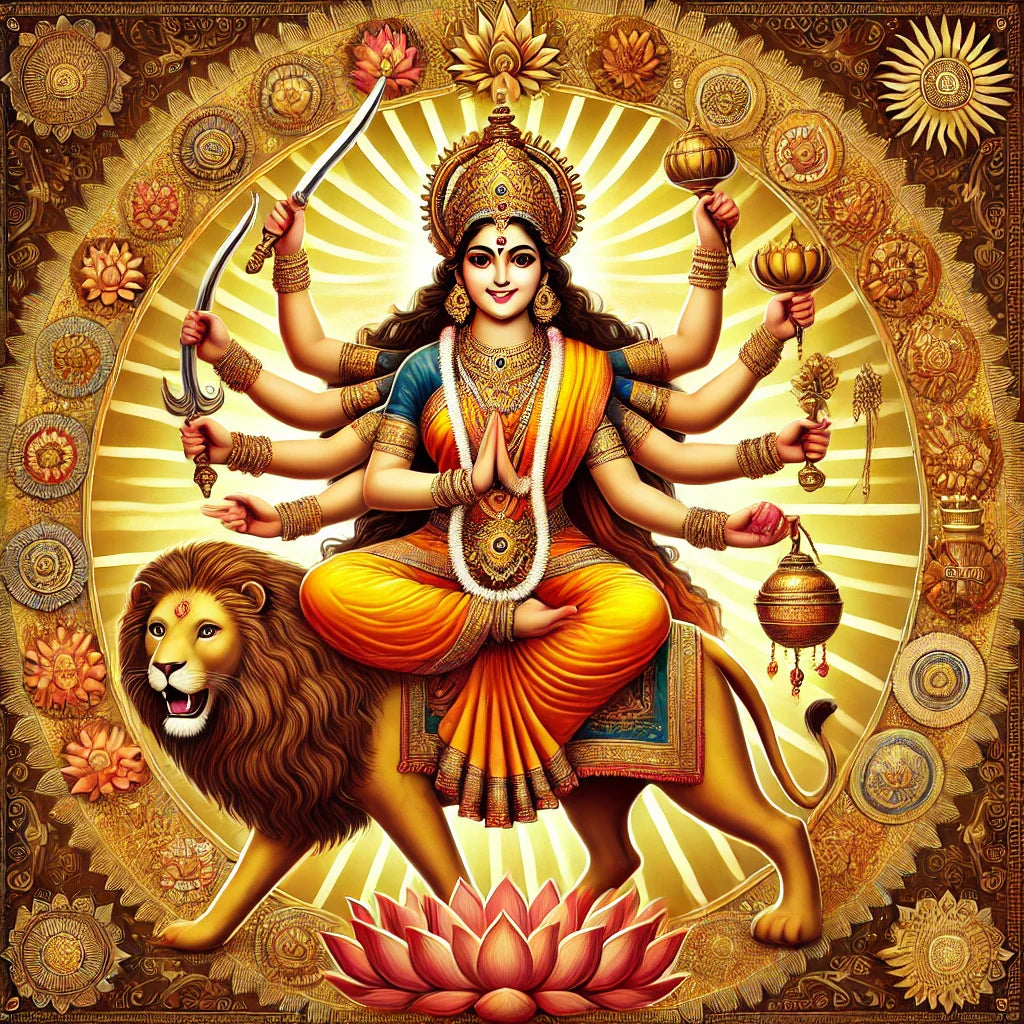
Goddess Kushmanda – The Cosmic Mother Who Smiles Creation into Being
Share
On Navratri Day 4, devotees worship Goddess Kushmanda, the fourth form of Navadurga, whose gentle cosmic smile is believed to have sparked the creation of the universe. Her name is derived from three Sanskrit words: Ku (a little), Ushma (warmth or energy), and Anda (cosmic egg), symbolizing the goddess who creates the universe from a tiny divine spark of energy. She is also revered as Adisakti, the primeval energy behind all manifestation.
Mythological Origin and Significance
According to Hindu scriptures, when the universe was shrouded in darkness and chaos, Goddess Kushmanda's radiance illuminated the void, initiating the process of creation. Her divine smile emitted the solar energy that gave rise to the sun, stars, and all living beings. As the source of cosmic vitality, she is often linked to Surya (the Sun God) and is believed to reside in the core of the solar system, nurturing life with her warmth and divine will.
This form of Durga came into being to provide order, light, and balance to the cosmos. Hence, her worship is said to bestow life force (prana), vigor, and positive energy.
Iconography and Symbolism
Goddess Kushmanda is depicted with a radiant golden complexion, seated on a lion, signifying fearlessness and command. She has eight or ten hands, each holding symbolic items: Kamandalu – spiritual discipline, Dhanush and Baan (Bow and Arrow) – direction and focus, Chakra (Discus) – control over time and karma, Gada (Mace) – strength, Amrit Kalash (Nectar Pot) – life-giving energy, Lotus (Padma) – purity and serenity, Rosary (Japa Mala) – jnana (wisdom), Trishul (Trident) – destruction of ego and ignorance
She governs the Anahata Chakra (Heart Chakra), associated with love, compassion, and emotional balance.
Shop Pooja SamagriWhen and Why to Worship Goddess Kushmanda
Tithi: Fourth day (Chaturthi) of Shukla Paksha during Navratri
Best time: Morning hours, preferably Brahma Muhurta
Reasons to Worship Her:
Worshipping Kushmanada, Enhances health, vitality, and emotional well-being, Clears obstacles in career or spiritual practice, and Blesses devotees with mental strength and intuitive power.
Ideal for healing from emotional wounds or stress
How to Worship – Puja Vidhi
Color of the Day: Orange
Preferred Flowers: Marigold (गेंदे का फूल), Hibiscus
Offerings: Malpua, pumpkin (कद्दू), jaggery, milk
Bathe early and wear orange clothing. Decorate the altar with flowers and diya (lamp), Place the idol or image of Goddess Kushmanda. Offer Malpua or pumpkin dishes as Naivedya. Chant her mantras and stotras with devotion. Perform aarti with bells and incense. Meditate on her smiling form and cosmic presence
Mantras of Goddess Kushmanda
Dhyana Mantra (ध्यान मंत्र)
सुरासंपूर्णकलशं रुधिराप्लुतमेव च।
दधाना हस्तपद्माभ्यां कूष्माण्डा शुभदास्तु मे॥
Surāsaṁpūrṇakalaśaṁ rudhirāplutameva ca,
Dadhānā hastapadmābhyāṁ Kūṣmāṇḍā śubhadāstu me.
Meaning: “May Goddess Kushmanda, who holds a blood-filled pot and a nectar-filled kalash in her hands, bless me with auspiciousness and joy.”
Symbolism: She balances destruction and creation, holding both nourishment and fierce protection in her hands.
Beej Mantra (बीज मंत्र)
ॐ कूष्माण्डायै नमः॥
Om Kūṣmāṇḍāyai Namaḥ.
Effect: Invoking her core vibrational energy, this mantra fosters creativity, positivity, and healing.
Navadurga Stotra Mantra
या देवी सर्वभूतेषु कूष्माण्डा रूपेण संस्थिता।
नमस्तस्यै नमस्तस्यै नमस्तस्यै नमो नमः॥
Yā Devī Sarvabhūteṣu Kūṣmāṇḍā rūpeṇa saṁsthitā,
Namastasyai Namastasyai Namastasyai Namo Namaḥ.
Purpose: A humble prayer acknowledging her presence in all beings and seeking her blessings.
Stotra for Blessings
जय अष्टभुजा मां कूष्माण्डा माता।
सुख संपत्ति करहुं दिन राता॥
Jaya aṣṭabhuja māṁ Kūṣmāṇḍā mātā,
Sukh saṁpatti karahuṁ din rātā.
Translation: “Victory to Mother Kushmanda with eight arms; grant me joy and prosperity day and night.”
Deeper Symbolism & Spiritual Insights
Goddess Kushmanda teaches that creation begins with inner light and joy. Her smile alone brought the cosmos into existence, signifying that true power lies in effortless energy, not force. She nurtures life by infusing it with prana (vital energy), emotional warmth, and unshakable courage.
By meditating on her, one can restore the heart chakra, overcome emotional blockages, and ignite the creative spark needed to manifest dreams into reality.
Shop Pooja Samagri
Conclusion
Goddess Kushmanda is the smiling mother of the universe, the primordial light who brings warmth, vitality, and order into chaos. Her divine energy teaches us to create our reality with joy, to remain centered in love, and to wield our power gently yet purposefully.
On Navratri Day 4, may her radiant blessings illuminate your mind, heart, and life path with infinite strength and peace.
Know more about Navratri day 3
Frequently Asked Questions (FAQs)
Q1: Why is she associated with the Sun?
Because she is the source of solar energy and vitality, believed to reside in the core of Surya Mandala (Solar System).
Q2: What does her name mean?
Kushmanda = Ku (small) + Ushma (energy) + Anda (cosmic egg) – “She who created the universe from a tiny spark of warmth.”
Q3: Is fasting compulsory?
Not mandatory, but eating sattvic food and practicing mental discipline is highly beneficial.
Q4: Who should worship her?
Ideal for those seeking mental healing, spiritual strength, creativity, and energy renewal.
Q5: What day of Navratri is she worshipped?
She is worshipped on Chaturthi Tithi, the fourth day of Navratri.
